 Attack in a snowstorm on the 100 Shaku Cliff in Weihaiwei Bay. Print shows a Japanese officer on horseback fighting with many Chinese soldiers near Weihaiwei during a snowstorm. Stock Photohttps://www.alamy.com/licenses-and-pricing/?v=1https://www.alamy.com/attack-in-a-snowstorm-on-the-100-shaku-cliff-in-weihaiwei-bay-print-shows-a-japanese-officer-on-horseback-fighting-with-many-chinese-soldiers-near-weihaiwei-during-a-snowstorm-image257285993.html
Attack in a snowstorm on the 100 Shaku Cliff in Weihaiwei Bay. Print shows a Japanese officer on horseback fighting with many Chinese soldiers near Weihaiwei during a snowstorm. Stock Photohttps://www.alamy.com/licenses-and-pricing/?v=1https://www.alamy.com/attack-in-a-snowstorm-on-the-100-shaku-cliff-in-weihaiwei-bay-print-shows-a-japanese-officer-on-horseback-fighting-with-many-chinese-soldiers-near-weihaiwei-during-a-snowstorm-image257285993.htmlRMTXGAWD–Attack in a snowstorm on the 100 Shaku Cliff in Weihaiwei Bay. Print shows a Japanese officer on horseback fighting with many Chinese soldiers near Weihaiwei during a snowstorm.
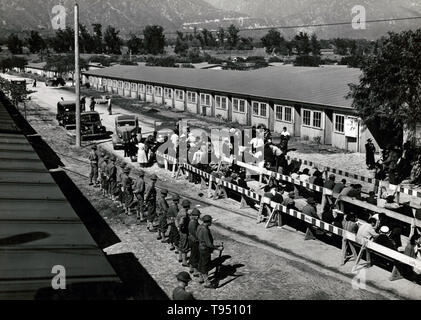 Entitled: 'Japanese waiting for registration at the Santa Anita reception center.' The internment of Japanese-Americans during WWII was the forced relocation and incarceration in camps of 110,000-120,000 people of Japanese ancestry (62% of the internees were US citizens) ordered by President Roosevelt shortly after Japan's attack on Pearl Harbor. Japanese-Americans were incarcerated based on local population concentrations and regional politics. Stock Photohttps://www.alamy.com/licenses-and-pricing/?v=1https://www.alamy.com/entitled-japanese-waiting-for-registration-at-the-santa-anita-reception-center-the-internment-of-japanese-americans-during-wwii-was-the-forced-relocation-and-incarceration-in-camps-of-110000-120000-people-of-japanese-ancestry-62-of-the-internees-were-us-citizens-ordered-by-president-roosevelt-shortly-after-japans-attack-on-pearl-harbor-japanese-americans-were-incarcerated-based-on-local-population-concentrations-and-regional-politics-image246587601.html
Entitled: 'Japanese waiting for registration at the Santa Anita reception center.' The internment of Japanese-Americans during WWII was the forced relocation and incarceration in camps of 110,000-120,000 people of Japanese ancestry (62% of the internees were US citizens) ordered by President Roosevelt shortly after Japan's attack on Pearl Harbor. Japanese-Americans were incarcerated based on local population concentrations and regional politics. Stock Photohttps://www.alamy.com/licenses-and-pricing/?v=1https://www.alamy.com/entitled-japanese-waiting-for-registration-at-the-santa-anita-reception-center-the-internment-of-japanese-americans-during-wwii-was-the-forced-relocation-and-incarceration-in-camps-of-110000-120000-people-of-japanese-ancestry-62-of-the-internees-were-us-citizens-ordered-by-president-roosevelt-shortly-after-japans-attack-on-pearl-harbor-japanese-americans-were-incarcerated-based-on-local-population-concentrations-and-regional-politics-image246587601.htmlRMT95101–Entitled: 'Japanese waiting for registration at the Santa Anita reception center.' The internment of Japanese-Americans during WWII was the forced relocation and incarceration in camps of 110,000-120,000 people of Japanese ancestry (62% of the internees were US citizens) ordered by President Roosevelt shortly after Japan's attack on Pearl Harbor. Japanese-Americans were incarcerated based on local population concentrations and regional politics.
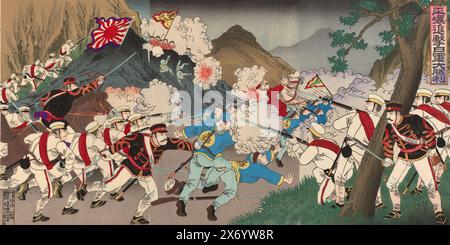 The victory of the Japanese army in the attack on Pyongyang, Heijô shingeki nichigun daishôri (title on object), Japanese soldiers in the white summer uniform unexpectedly attack the Chinese from the left flank. This caused panic causing men to jump over the cliffs. More than 2,000 Chinese lost their lives in this battle near Pyongyang during the First Sino-Japanese War (1894-1895)., print, print maker: Watanabe Nobukazu, (mentioned on object), publisher: Hasegawa Tsunejirô, (mentioned on object), Japan, 1894, paper, color woodcut, polishing, height, 365 mm × width, 719 mm Stock Photohttps://www.alamy.com/licenses-and-pricing/?v=1https://www.alamy.com/the-victory-of-the-japanese-army-in-the-attack-on-pyongyang-heij-shingeki-nichigun-daishri-title-on-object-japanese-soldiers-in-the-white-summer-uniform-unexpectedly-attack-the-chinese-from-the-left-flank-this-caused-panic-causing-men-to-jump-over-the-cliffs-more-than-2000-chinese-lost-their-lives-in-this-battle-near-pyongyang-during-the-first-sino-japanese-war-1894-1895-print-print-maker-watanabe-nobukazu-mentioned-on-object-publisher-hasegawa-tsunejir-mentioned-on-object-japan-1894-paper-color-woodcut-polishing-height-365-mm-width-719-mm-image606663367.html
The victory of the Japanese army in the attack on Pyongyang, Heijô shingeki nichigun daishôri (title on object), Japanese soldiers in the white summer uniform unexpectedly attack the Chinese from the left flank. This caused panic causing men to jump over the cliffs. More than 2,000 Chinese lost their lives in this battle near Pyongyang during the First Sino-Japanese War (1894-1895)., print, print maker: Watanabe Nobukazu, (mentioned on object), publisher: Hasegawa Tsunejirô, (mentioned on object), Japan, 1894, paper, color woodcut, polishing, height, 365 mm × width, 719 mm Stock Photohttps://www.alamy.com/licenses-and-pricing/?v=1https://www.alamy.com/the-victory-of-the-japanese-army-in-the-attack-on-pyongyang-heij-shingeki-nichigun-daishri-title-on-object-japanese-soldiers-in-the-white-summer-uniform-unexpectedly-attack-the-chinese-from-the-left-flank-this-caused-panic-causing-men-to-jump-over-the-cliffs-more-than-2000-chinese-lost-their-lives-in-this-battle-near-pyongyang-during-the-first-sino-japanese-war-1894-1895-print-print-maker-watanabe-nobukazu-mentioned-on-object-publisher-hasegawa-tsunejir-mentioned-on-object-japan-1894-paper-color-woodcut-polishing-height-365-mm-width-719-mm-image606663367.htmlRM2X6YW8R–The victory of the Japanese army in the attack on Pyongyang, Heijô shingeki nichigun daishôri (title on object), Japanese soldiers in the white summer uniform unexpectedly attack the Chinese from the left flank. This caused panic causing men to jump over the cliffs. More than 2,000 Chinese lost their lives in this battle near Pyongyang during the First Sino-Japanese War (1894-1895)., print, print maker: Watanabe Nobukazu, (mentioned on object), publisher: Hasegawa Tsunejirô, (mentioned on object), Japan, 1894, paper, color woodcut, polishing, height, 365 mm × width, 719 mm
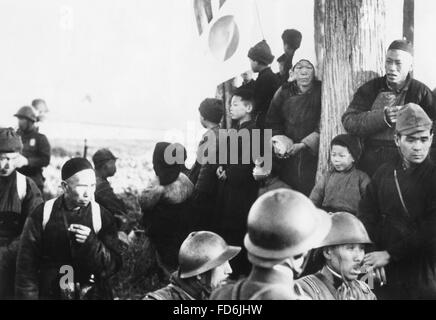 Japanese attack on Singapore on 02/15/1942 Stock Photohttps://www.alamy.com/licenses-and-pricing/?v=1https://www.alamy.com/stock-photo-japanese-attack-on-singapore-on-02151942-94188693.html
Japanese attack on Singapore on 02/15/1942 Stock Photohttps://www.alamy.com/licenses-and-pricing/?v=1https://www.alamy.com/stock-photo-japanese-attack-on-singapore-on-02151942-94188693.htmlRMFD6JHW–Japanese attack on Singapore on 02/15/1942
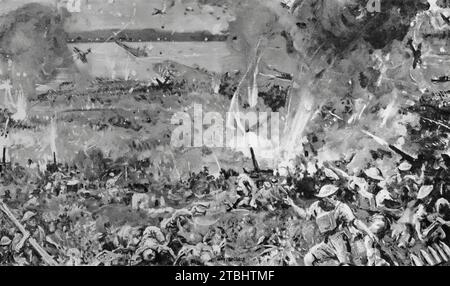 A drawing by T. C. Douglas showing British artillery fire near the Causeway on Singapore Island during the Second World War. The British rearguard action in February 1942 was defeated by overwhelming numbers of Japanese troops, their artillery and massive air support. Stock Photohttps://www.alamy.com/licenses-and-pricing/?v=1https://www.alamy.com/a-drawing-by-t-c-douglas-showing-british-artillery-fire-near-the-causeway-on-singapore-island-during-the-second-world-war-the-british-rearguard-action-in-february-1942-was-defeated-by-overwhelming-numbers-of-japanese-troops-their-artillery-and-massive-air-support-image575095935.html
A drawing by T. C. Douglas showing British artillery fire near the Causeway on Singapore Island during the Second World War. The British rearguard action in February 1942 was defeated by overwhelming numbers of Japanese troops, their artillery and massive air support. Stock Photohttps://www.alamy.com/licenses-and-pricing/?v=1https://www.alamy.com/a-drawing-by-t-c-douglas-showing-british-artillery-fire-near-the-causeway-on-singapore-island-during-the-second-world-war-the-british-rearguard-action-in-february-1942-was-defeated-by-overwhelming-numbers-of-japanese-troops-their-artillery-and-massive-air-support-image575095935.htmlRM2TBHTMF–A drawing by T. C. Douglas showing British artillery fire near the Causeway on Singapore Island during the Second World War. The British rearguard action in February 1942 was defeated by overwhelming numbers of Japanese troops, their artillery and massive air support.
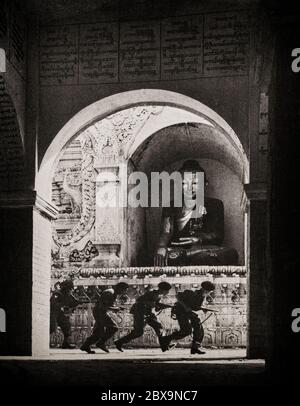 British and Indian soldiers creep passed a Buddha on Pagoda Hill as they charge an enemy position in Mandalay, during Operation Dracula, a World War II-airborne and amphibious attack on Rangoon by British, American and Indian forces during the Burma Campaign, launched during April and May 1945. Stock Photohttps://www.alamy.com/licenses-and-pricing/?v=1https://www.alamy.com/british-and-indian-soldiers-creep-passed-a-buddha-on-pagoda-hill-as-they-charge-an-enemy-position-in-mandalay-during-operation-dracula-a-world-war-ii-airborne-and-amphibious-attack-on-rangoon-by-british-american-and-indian-forces-during-the-burma-campaign-launched-during-april-and-may-1945-image360402791.html
British and Indian soldiers creep passed a Buddha on Pagoda Hill as they charge an enemy position in Mandalay, during Operation Dracula, a World War II-airborne and amphibious attack on Rangoon by British, American and Indian forces during the Burma Campaign, launched during April and May 1945. Stock Photohttps://www.alamy.com/licenses-and-pricing/?v=1https://www.alamy.com/british-and-indian-soldiers-creep-passed-a-buddha-on-pagoda-hill-as-they-charge-an-enemy-position-in-mandalay-during-operation-dracula-a-world-war-ii-airborne-and-amphibious-attack-on-rangoon-by-british-american-and-indian-forces-during-the-burma-campaign-launched-during-april-and-may-1945-image360402791.htmlRM2BX9NC7–British and Indian soldiers creep passed a Buddha on Pagoda Hill as they charge an enemy position in Mandalay, during Operation Dracula, a World War II-airborne and amphibious attack on Rangoon by British, American and Indian forces during the Burma Campaign, launched during April and May 1945.
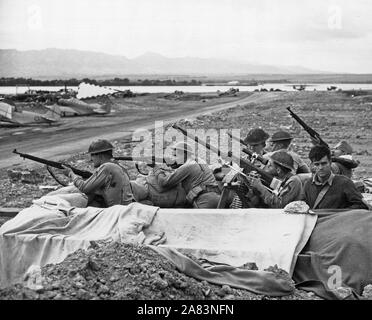 Gun crews during the Japanese attack on Pearl Harbor, Dec. 7 1941. Marines and soldiers fire on raiding Japanese planes. Stock Photohttps://www.alamy.com/licenses-and-pricing/?v=1https://www.alamy.com/gun-crews-during-the-japanese-attack-on-pearl-harbor-dec-7-1941-marines-and-soldiers-fire-on-raiding-japanese-planes-image331997001.html
Gun crews during the Japanese attack on Pearl Harbor, Dec. 7 1941. Marines and soldiers fire on raiding Japanese planes. Stock Photohttps://www.alamy.com/licenses-and-pricing/?v=1https://www.alamy.com/gun-crews-during-the-japanese-attack-on-pearl-harbor-dec-7-1941-marines-and-soldiers-fire-on-raiding-japanese-planes-image331997001.htmlRM2A83NFN–Gun crews during the Japanese attack on Pearl Harbor, Dec. 7 1941. Marines and soldiers fire on raiding Japanese planes.
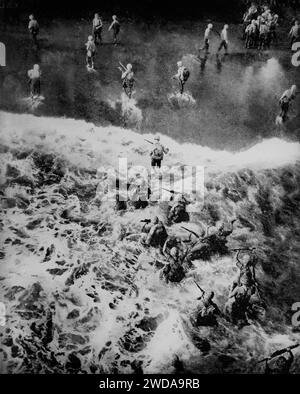 U.S. Marines wade ashore on the Pacific Marshall Islands during the Second World War, The islands, an important tactical base for the Japanese were almost completely occupied by American forces by the 5th February 1944. Stock Photohttps://www.alamy.com/licenses-and-pricing/?v=1https://www.alamy.com/us-marines-wade-ashore-on-the-pacific-marshall-islands-during-the-second-world-war-the-islands-an-important-tactical-base-for-the-japanese-were-almost-completely-occupied-by-american-forces-by-the-5th-february-1944-image593370271.html
U.S. Marines wade ashore on the Pacific Marshall Islands during the Second World War, The islands, an important tactical base for the Japanese were almost completely occupied by American forces by the 5th February 1944. Stock Photohttps://www.alamy.com/licenses-and-pricing/?v=1https://www.alamy.com/us-marines-wade-ashore-on-the-pacific-marshall-islands-during-the-second-world-war-the-islands-an-important-tactical-base-for-the-japanese-were-almost-completely-occupied-by-american-forces-by-the-5th-february-1944-image593370271.htmlRM2WDA9RB–U.S. Marines wade ashore on the Pacific Marshall Islands during the Second World War, The islands, an important tactical base for the Japanese were almost completely occupied by American forces by the 5th February 1944.
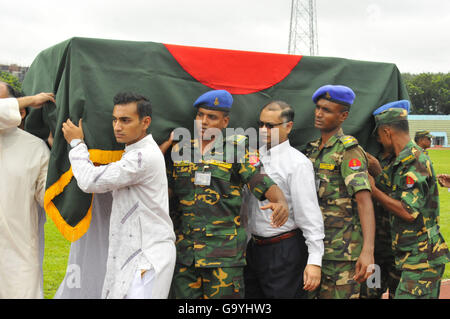 Dhaka, Bangladesh. 4th July, 2016. Bangladesh Army soldiers carry a coffin containing the body of a victim during a memorial service for those killed in a bloody siege at the Army Stadium in Dhaka, Bangladesh, July 4, 2016. Nine Italians, seven Japanese, two Bangladeshis, a Bangladeshi-born U.S. citizen and an Indian female were killed in the attack on the Spanish restaurant in Dhaka popular with foreigners last week. Credit: Shariful Islam/Xinhua/Alamy Live News Stock Photohttps://www.alamy.com/licenses-and-pricing/?v=1https://www.alamy.com/stock-photo-dhaka-bangladesh-4th-july-2016-bangladesh-army-soldiers-carry-a-coffin-109400847.html
Dhaka, Bangladesh. 4th July, 2016. Bangladesh Army soldiers carry a coffin containing the body of a victim during a memorial service for those killed in a bloody siege at the Army Stadium in Dhaka, Bangladesh, July 4, 2016. Nine Italians, seven Japanese, two Bangladeshis, a Bangladeshi-born U.S. citizen and an Indian female were killed in the attack on the Spanish restaurant in Dhaka popular with foreigners last week. Credit: Shariful Islam/Xinhua/Alamy Live News Stock Photohttps://www.alamy.com/licenses-and-pricing/?v=1https://www.alamy.com/stock-photo-dhaka-bangladesh-4th-july-2016-bangladesh-army-soldiers-carry-a-coffin-109400847.htmlRMG9YHW3–Dhaka, Bangladesh. 4th July, 2016. Bangladesh Army soldiers carry a coffin containing the body of a victim during a memorial service for those killed in a bloody siege at the Army Stadium in Dhaka, Bangladesh, July 4, 2016. Nine Italians, seven Japanese, two Bangladeshis, a Bangladeshi-born U.S. citizen and an Indian female were killed in the attack on the Spanish restaurant in Dhaka popular with foreigners last week. Credit: Shariful Islam/Xinhua/Alamy Live News
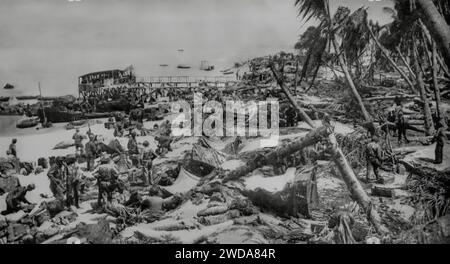 The aftermath of the storming of Tarawa Beach in the Gilbert Islands by U.S. Marines. The assault on 20th November 1943, on the islands during the Second World War was one of the bloodiest of the war with over a 1,000 Americans killed, many injured and 5,000 Japanese troops Stock Photohttps://www.alamy.com/licenses-and-pricing/?v=1https://www.alamy.com/the-aftermath-of-the-storming-of-tarawa-beach-in-the-gilbert-islands-by-us-marines-the-assault-on-20th-november-1943-on-the-islands-during-the-second-world-war-was-one-of-the-bloodiest-of-the-war-with-over-a-1000-americans-killed-many-injured-and-5000-japanese-troops-image593368967.html
The aftermath of the storming of Tarawa Beach in the Gilbert Islands by U.S. Marines. The assault on 20th November 1943, on the islands during the Second World War was one of the bloodiest of the war with over a 1,000 Americans killed, many injured and 5,000 Japanese troops Stock Photohttps://www.alamy.com/licenses-and-pricing/?v=1https://www.alamy.com/the-aftermath-of-the-storming-of-tarawa-beach-in-the-gilbert-islands-by-us-marines-the-assault-on-20th-november-1943-on-the-islands-during-the-second-world-war-was-one-of-the-bloodiest-of-the-war-with-over-a-1000-americans-killed-many-injured-and-5000-japanese-troops-image593368967.htmlRM2WDA84R–The aftermath of the storming of Tarawa Beach in the Gilbert Islands by U.S. Marines. The assault on 20th November 1943, on the islands during the Second World War was one of the bloodiest of the war with over a 1,000 Americans killed, many injured and 5,000 Japanese troops
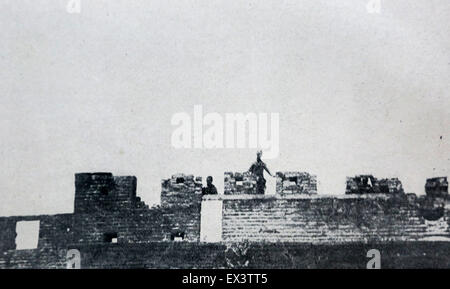 Chongqing. 6th July, 2015. This undated copied file photo shows Chinese soldiers keeping guard on the wall of Wanping County after an attack by invading Japanese troops. A batch of file recording Lugouqiao Incident during the anti-Japanese war were released by Chongqing Beibei District Archive on July 6, 2015. On July 7, 1937, Japanese aggressors first bombarded Wanping County Town, then attacked the Lugouqiao Bridge to start a full-scale war of aggression against China in an attempt to put all the country under its colonial rule. Credit: Xinhua/Alamy Live News Stock Photohttps://www.alamy.com/licenses-and-pricing/?v=1https://www.alamy.com/stock-photo-chongqing-6th-july-2015-this-undated-copied-file-photo-shows-chinese-84907877.html
Chongqing. 6th July, 2015. This undated copied file photo shows Chinese soldiers keeping guard on the wall of Wanping County after an attack by invading Japanese troops. A batch of file recording Lugouqiao Incident during the anti-Japanese war were released by Chongqing Beibei District Archive on July 6, 2015. On July 7, 1937, Japanese aggressors first bombarded Wanping County Town, then attacked the Lugouqiao Bridge to start a full-scale war of aggression against China in an attempt to put all the country under its colonial rule. Credit: Xinhua/Alamy Live News Stock Photohttps://www.alamy.com/licenses-and-pricing/?v=1https://www.alamy.com/stock-photo-chongqing-6th-july-2015-this-undated-copied-file-photo-shows-chinese-84907877.htmlRMEX3TT5–Chongqing. 6th July, 2015. This undated copied file photo shows Chinese soldiers keeping guard on the wall of Wanping County after an attack by invading Japanese troops. A batch of file recording Lugouqiao Incident during the anti-Japanese war were released by Chongqing Beibei District Archive on July 6, 2015. On July 7, 1937, Japanese aggressors first bombarded Wanping County Town, then attacked the Lugouqiao Bridge to start a full-scale war of aggression against China in an attempt to put all the country under its colonial rule. Credit: Xinhua/Alamy Live News
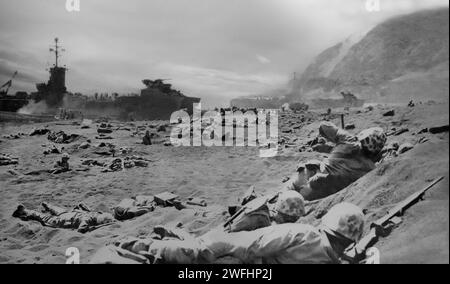 U.S. Marines preparing to advance from the beach on Iwojima, within the Ogasawara Archipelago in the Pacific Ocean. The Japanese occupiers fiercely defended the island to the death, most died and took over 4,000 Marines with them. The invasion took place on the 16th March, 1945 during the final year of the Second World War. Stock Photohttps://www.alamy.com/licenses-and-pricing/?v=1https://www.alamy.com/us-marines-preparing-to-advance-from-the-beach-on-iwojima-within-the-ogasawara-archipelago-in-the-pacific-ocean-the-japanese-occupiers-fiercely-defended-the-island-to-the-death-most-died-and-took-over-4000-marines-with-them-the-invasion-took-place-on-the-16th-march-1945-during-the-final-year-of-the-second-world-war-image594762858.html
U.S. Marines preparing to advance from the beach on Iwojima, within the Ogasawara Archipelago in the Pacific Ocean. The Japanese occupiers fiercely defended the island to the death, most died and took over 4,000 Marines with them. The invasion took place on the 16th March, 1945 during the final year of the Second World War. Stock Photohttps://www.alamy.com/licenses-and-pricing/?v=1https://www.alamy.com/us-marines-preparing-to-advance-from-the-beach-on-iwojima-within-the-ogasawara-archipelago-in-the-pacific-ocean-the-japanese-occupiers-fiercely-defended-the-island-to-the-death-most-died-and-took-over-4000-marines-with-them-the-invasion-took-place-on-the-16th-march-1945-during-the-final-year-of-the-second-world-war-image594762858.htmlRM2WFHP2J–U.S. Marines preparing to advance from the beach on Iwojima, within the Ogasawara Archipelago in the Pacific Ocean. The Japanese occupiers fiercely defended the island to the death, most died and took over 4,000 Marines with them. The invasion took place on the 16th March, 1945 during the final year of the Second World War.